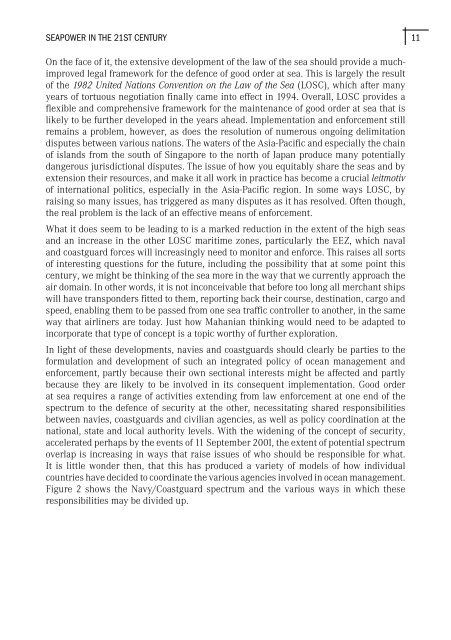Australian Maritime Issues 2005 - Royal Australian Navy
Australian Maritime Issues 2005 - Royal Australian Navy
Australian Maritime Issues 2005 - Royal Australian Navy
You also want an ePaper? Increase the reach of your titles
YUMPU automatically turns print PDFs into web optimized ePapers that Google loves.
SEAPOWER IN THE 21ST CENTURY<br />
11<br />
On the face of it, the extensive development of the law of the sea should provide a muchimproved<br />
legal framework for the defence of good order at sea. This is largely the result<br />
of the 1982 United Nations Convention on the Law of the Sea (LOSC), which after many<br />
years of tortuous negotiation finally came into effect in 1994. Overall, LOSC provides a<br />
flexible and comprehensive framework for the maintenance of good order at sea that is<br />
likely to be further developed in the years ahead. Implementation and enforcement still<br />
remains a problem, however, as does the resolution of numerous ongoing delimitation<br />
disputes between various nations. The waters of the Asia-Pacific and especially the chain<br />
of islands from the south of Singapore to the north of Japan produce many potentially<br />
dangerous jurisdictional disputes. The issue of how you equitably share the seas and by<br />
extension their resources, and make it all work in practice has become a crucial leitmotiv<br />
of international politics, especially in the Asia-Pacific region. In some ways LOSC, by<br />
raising so many issues, has triggered as many disputes as it has resolved. Often though,<br />
the real problem is the lack of an effective means of enforcement.<br />
What it does seem to be leading to is a marked reduction in the extent of the high seas<br />
and an increase in the other LOSC maritime zones, particularly the EEZ, which naval<br />
and coastguard forces will increasingly need to monitor and enforce. This raises all sorts<br />
of interesting questions for the future, including the possibility that at some point this<br />
century, we might be thinking of the sea more in the way that we currently approach the<br />
air domain. In other words, it is not inconceivable that before too long all merchant ships<br />
will have transponders fitted to them, reporting back their course, destination, cargo and<br />
speed, enabling them to be passed from one sea traffic controller to another, in the same<br />
way that airliners are today. Just how Mahanian thinking would need to be adapted to<br />
incorporate that type of concept is a topic worthy of further exploration.<br />
In light of these developments, navies and coastguards should clearly be parties to the<br />
formulation and development of such an integrated policy of ocean management and<br />
enforcement, partly because their own sectional interests might be affected and partly<br />
because they are likely to be involved in its consequent implementation. Good order<br />
at sea requires a range of activities extending from law enforcement at one end of the<br />
spectrum to the defence of security at the other, necessitating shared responsibilities<br />
between navies, coastguards and civilian agencies, as well as policy coordination at the<br />
national, state and local authority levels. With the widening of the concept of security,<br />
accelerated perhaps by the events of 11 September 2001, the extent of potential spectrum<br />
overlap is increasing in ways that raise issues of who should be responsible for what.<br />
It is little wonder then, that this has produced a variety of models of how individual<br />
countries have decided to coordinate the various agencies involved in ocean management.<br />
Figure 2 shows the <strong>Navy</strong>/Coastguard spectrum and the various ways in which these<br />
responsibilities may be divided up.

















